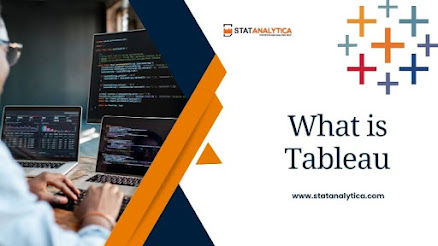Tableau is a powerful tool utilized for data visualization, aiding individuals and organizations in comprehending their data visually and clearly. Its functionality extends beyond just representation, offering a complete suite of features that cater to various user needs, making data analysis and interpretation more accessible and efficient.
Understanding Tableau's Purpose
Tableau is designed to transform raw data into meaningful insights. It allows users to connect to diverse data sources like spreadsheets, databases, or cloud services, simplifying importing and organizing data. Once connected, Tableau offers various visualization options such as charts, graphs, and maps, enabling users to present complex details in an easily digestible format.
Exploring How Tableau is Used
Using Tableau is a straightforward process:
- Data is connected to Tableau from various sources.
- Drag and drop pieces are used in the interface to make visualizations. Users can change what is shown by using filters and factors to improve how data is shown.
- Tableau's calculations and formulas allow for in-depth analysis, providing a deeper understanding of the data.
Feature of Tableau
As a robust data visualization and analytics tool, Tableau encompasses many features that empower users to explore, analyze, and present data effectively. Some of its prominent features include:
1. Data Connection and Integration
Tableau offers seamless connectivity to various data sources, including databases, spreadsheets, cloud services, and more. Its integration with diverse data types enables users to work with data from multiple platforms within a unified interface.
2. Drag-and-Drop Interface
The simple drag-and-drop design makes it easier to make visualizations. Users can effortlessly drag fields onto shelves to generate charts, graphs, maps, and other visual representations without extensive coding or technical skills.
3. Diverse Visualization Options
Tableau provides various visualization choices, from simple bar graphs to complex dashboards and interactive storyboards. Users can select the most suitable visualization to present data effectively based on the nature of the information they want to convey.
4. Real-Time Data Updates
The ability to connect to live data sources allows for real-time updates in visualizations. Users can set up live connections to ensure the data displayed is always current, enabling timely decision-making based on the most recent information.
5. Calculations and Formulas
Tableau includes a robust set of calculations and formulas that enable users to perform in-depth analysis within the tool. From basic arithmetic calculations to complex statistical functions, users can derive new insights and create calculated fields without leaving the Tableau environment.
6. Interactive Dashboards
The interactivity feature of Tableau allows users to create dashboards that respond dynamically to user actions. Filters, parameters, and actions can be implemented to enable users to explore data interactively, drilling down into specific aspects for deeper analysis.
7. Collaboration and Sharing
Tableau facilitates collaboration by allowing users to easily share their visualizations, dashboards, and insights. Users can publish their work to Tableau Server or Tableau Online, enabling team members to access and collaborate on the same visualizations.
8. Mobile Accessibility
Tableau's mobile app ensures that users can access and interact with visualizations on various devices, including smartphones and tablets. This feature ensures that stakeholders can view and explore data while moving.
9. Scalability and Performance
Tableau's architecture is designed for scalability, allowing it to handle vast amounts of data efficiently without compromising performance. Whether dealing with small datasets or massive volumes of information, Tableau maintains responsiveness and usability.
10. Advanced Analytics and Integration with Statistical Tools
Advanced analytics capabilities within Tableau enable users to conduct predictive analysis, clustering, forecasting, and more. Integration with statistical tools like R and Python extends its analytical capabilities, empowering users to perform advanced analyses within Tableau.
Read More: How to Learn Tableau for Beginners
Benefits of Utilizing Tableau
- User-Friendly Interface: Tableau's intuitive interface makes it accessible to users with varying technical expertise.
- Versatile Visualizations: It offers diverse visualization options, from basic charts to sophisticated dashboards and storyboards. This versatility aids in presenting data according to specific needs.
- Real-Time Updates: Tableau enables real-time data connectivity, ensuring visualizations reflect current information. This feature is invaluable for making data-driven decisions promptly.
- Interactivity and Collaboration: Visualizations created in Tableau are interactive, allowing users to explore data dynamically. Moreover, it facilitates collaboration by allowing users to share dashboards and reports quickly.
- Scalability: Tableau's scalability makes it suitable for both individuals and large enterprises. It efficiently handles small datasets and massive volumes of data without compromising performance.
- Enhanced Decision-Making: By providing insights in a visually compelling manner, Tableau aids in making informed decisions based on data trends and patterns.
Practical Applications of Tableau
- Business Intelligence: Businesses utilize Tableau to analyze sales trends, customer behavior, and market insights in-depth. It helps in strategic planning and improving operational efficiency.
- Healthcare and Research: Tableau assists healthcare professionals in analyzing patient data, tracking outcomes, and identifying trends, thereby improving patient care and research outcomes.
- Education and Non-Profit Sector: Educational institutions and non-profit organizations use Tableau to track student performance, manage resources effectively, and showcase impact reports to stakeholders.
Conclusion
In conclusion, Tableau serves as a pivotal tool in the realm of data analysis and visualization. Its user-friendly interface, diverse visualization options, real-time updates, and scalability make it valuable for businesses, researchers, educators, and other sectors. By transforming complex data into understandable visuals, Tableau empowers users to make informed decisions, enhancing efficiency and productivity.
Remember, while Tableau streamlines the process of data analysis, its true power lies in the hands of the users, leveraging its capabilities to extract meaningful insights from the vast realm of data.

Comments
Post a Comment